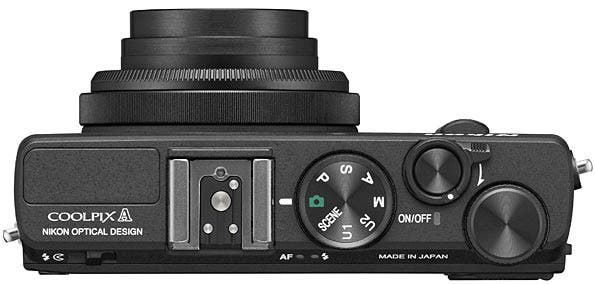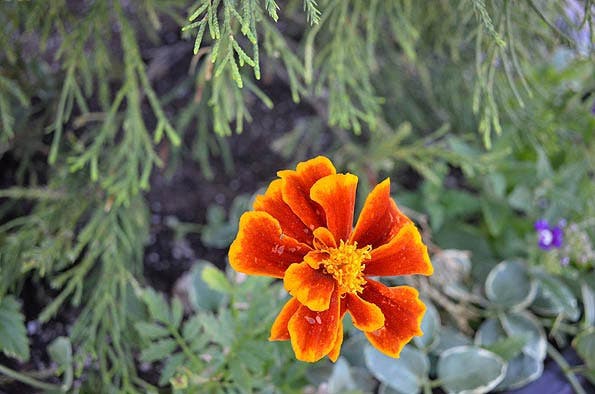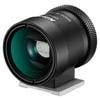Can this minuscule marvel rival DSLRs for image quality and performance? Check out how the Nikon Coolpix A did on the street and in the lab in this exclusive in-depth Adorama Learning Center product review.

If you were to view a photo taken with the pocket-sized Nikon Coolpix A ($1,096.95 at Adorama) side-by-side with a photo shot using a Nikon D3200 DSLR (or a D5200, or even a D7100), it is very likely you won’t be able to tell which photo came from which camera. The Nikon Coolpix A is the smallest Nikon to sport an APS-C sized sensor, and the results are spectacular.
Let’s back up. When it introduced the Nikon Coolpix A in April, Nikon joined an increasingly competitive, relatively new category of cameras: Compact cameras with prime lenses and APS sensors. It aspires to be a nimble little street-smart camera that can be used for unobtrusive, candid photography including photojournalism and street photography. But, unlike most compact digital cameras, it promises DSLR image qualtiy thanks to its supersized sensor. Does the Nikon Coolpix A have what it takes to deliver a pro-caliber compact camera that’s more in the image quality range of a Leica M than any previous Coolpix? Let’s find out.
First, check out this overview of the Nikon Coolpix A, featuring Diane Wallace, and shot exclusively for AdoramaTV, then continue to scroll down for our in-depth review…
In the hands
The Nikon Coolpix A has a solid, if slightly boxy, feel. Controls are logically placed, with a thumb wheel controlling different features based on mode in use, a separate ring around the “OK” button, and an honest-to-goodness focusing ring at the base of the lens barrel. When off, the lens collapses into the camera body, with only the focus ring and a little more protruding about 1/3 inch. Turn the camera on and the lens quickly jumps to full extension.
If you are used to a more advanced Nikon DLSR such as the D7100, the back of the Coolpix A will be instantly familiar. A column of controls lines the left side of the camera, next to the 3-inch LCD finder, and more controls on the right side. A comfortable, rubberized thumb rest is well placed on the upper right corner.

The fastest way to access most controls is through the convenient “I” menu, which brings up image quality, White Balance, ISO, function buttons, shutter release mode, focus and metering options, bracketing and other features. Although the Coolpix A shoots video, there’s no video button on the camera. To access video, go to Release mode in the “I” menu, and scroll down. Video is the sixth item down—fairly well-buried. Clearly, although the camera offers 1080p video at 30fps, Nikon wisely recognizes that the target user for this particular camera is not likely to use it as a video camera.
The LCD monitor, at 921k dots, offers very good resolution, although as with most LCD monitors, it can be difficult to view images or live view in direct sunlight. That’s why Nikon announced the TK optical viewfinder, a bright line finder that is matched to cover the same 28mm equivalent angle of view as the camera’s lens. Simply slip the finder into the hot shoe and you’re set. I found the image quality to be excellent, but if you find this to be too pricey, the Voigtlander 28mm viewfinder is a high-quality, affordable alternative.

As a street photographer, I really appreciated the focusing ring around the base of the lens. Just turn it, the camera focuses. Just like a DSLR. Why this isn’t a standard feature on all posh point-and-shoots is a mystery to me so thank you, Nikon! Auto, manual and macro focus modes are set via a switch on the side of the camera. Focus goes as close as approximately 4 inches, although you have to set macro focus separately if you are in AF mode. In regular AF, you can focus to about a foot away. I
The Nikon Coolpix A has assignable function buttons, using the Setup menu. The Fn1 and Fn2 buttons are located on the back and front of the camera, respectively, and can be assigned from a menu of a total of 16 functionsbetween them. For instance, you can assign Fn2 to activate D-Lighting, and Fn1 to turn on RAW mode. You can customize the camera even more extensively via the “U1″ and U2” settings: Assign your most frequently used settings to these so you can quickly get to them when shooting.

While seasoned photographers may be perfectly happy with manual exposure and focus, creative-minded shooters will appreciate the camera’s 19 scene modes, including Pet Portrait, candlelight, blossom, autumn colors, food, high and low key, sports, macro and more. Active D-Lighting, which lets you expand the effective dynamic range of any image either before or after exposure, is something Nikon came up with first, and does very, very well. No exception here.

In the field
Autofocus acquisition was quite fast, even in subdued light. It was almost but not quite as quick as with a DSLR. Macro focus tended to be a bit searchy. Manual focus via the lens ring was fast and reacted quickly to manual focus ring twists. My one niggling complaint here is that focus would resets to infinity every time the camera is turned off.
My acid test for performance on the street is to turn off all automatic settings and shoot in manual exposure and manual focus modes. My theory is that any camera will perform optimally in all-manual, since less processor resources are needed. The good news is that in Manual-everything, the Nikon Coolpix A is fast, with almost no shutter lag. The only area where it drags is if you have shot a sequence of RAW+JPEG images. The camera may lock down for a few seconds while the files are clearing the buffer.
You’ll want to shift the camera off of its default JPEG setting of Normal (1:8) compression and change it to Fine (1:4) for better image quality.
 Overall, I found the camera to be quite nimble on the street, and I was able to capture decisive moments without having to worry about lag time. As for the street photo stress test, the Nikon Cooplix A passed with flying colors, especially when used with an optical viewfinder such as the Voigtlander 28mm or Nikon DF-CP1 Optical Viewfinder (right), which is matched to the Coolpix A’s 28mm angle of view. If you want more precise focus (perhaps you’re shooting at the widest aperture, where exact focus is necessary) you can enlarge the live-view image and choose the degree of magnification so you can check focus. I found this feature was quick and easy to use.
Overall, I found the camera to be quite nimble on the street, and I was able to capture decisive moments without having to worry about lag time. As for the street photo stress test, the Nikon Cooplix A passed with flying colors, especially when used with an optical viewfinder such as the Voigtlander 28mm or Nikon DF-CP1 Optical Viewfinder (right), which is matched to the Coolpix A’s 28mm angle of view. If you want more precise focus (perhaps you’re shooting at the widest aperture, where exact focus is necessary) you can enlarge the live-view image and choose the degree of magnification so you can check focus. I found this feature was quick and easy to use.
Street Photo Stress Test









Image Quality
Unless you are a pixel peeper (as upposed to an actual photographer) you won’t really notice (or be adversely influenced) the difference between the image quality of the Nikon Coolpix A, D3200, and D7100. In fact, while the D7100 is marginally better, the A and 3200 scored a virtual dead heat in overall image quality, according to our lab test partner, DxOMark labs. Yes, the Nikon Coolpix A’s image quality, in both the lab and the street, matched that of today’s top DX (APS) sensor DSLRs.
The Nikon Coolpix A‘s noise levels stayed acceptable through ISO 1600, and images were still very usable by ISO 6400, an outstanding result. It beat all competitors when it came to dynamic range, demonstrating a 13.8-stop range, although it was edged out sligtly in color depth (23.4 bits).
Amazingly, among all APS-C cameras—not matter how large or small the camera—the Nikon Coolpix A came in 10th with an overall image quality rating of 80 (The Nikon D5200 scored the highest with an 84). It delivered the best image quality of all compact digital cameras tested by DxO.

Dynamic range: I shot the above with the Nikon Coolpix A in RAW+JPEG; the JPEG version showed no detail inside the restaurant, while the sunlit highlights were blown out. RAW version contained details that I was able to coax out in post-production.
Conclusion and recommendation
If you are looking wring the best image quality possible out of a compact digital camera, the Nikon Coolpix A is for you. In the lab and on the street, it delivered image quality that rivals results you’d expect from a DSLR, thanks to its DSLR-sized sensor and was fast and intuitive to use on the street. What more could you ask for?
Well, I’d ask for an optical viewfinder, and highly reccomend buying either the Nikon DF-CPI Optical Viewfinder, which will set you back $379, or a third-party solution such as the Voigtlander 28mm, which will ost $209 at Adorama. Either way, it will make street and other forms of photography easier to accomplish with the Nikon Coolpix A, and is well worth the extra cost.
Yes, the Coolpix A is pricier than some of its competitors; according to Nikon, this is because the camera is manufactured in Japan under Nikon’s watchful quality-control supervision. That said, in an era where compact camera makers much differentiate themselves and give cell phone users a compelling reason to step up, the Nikon Coolpix A, which is available now from Adorama for $1,096.95 in black or silver, has hit a home run.






